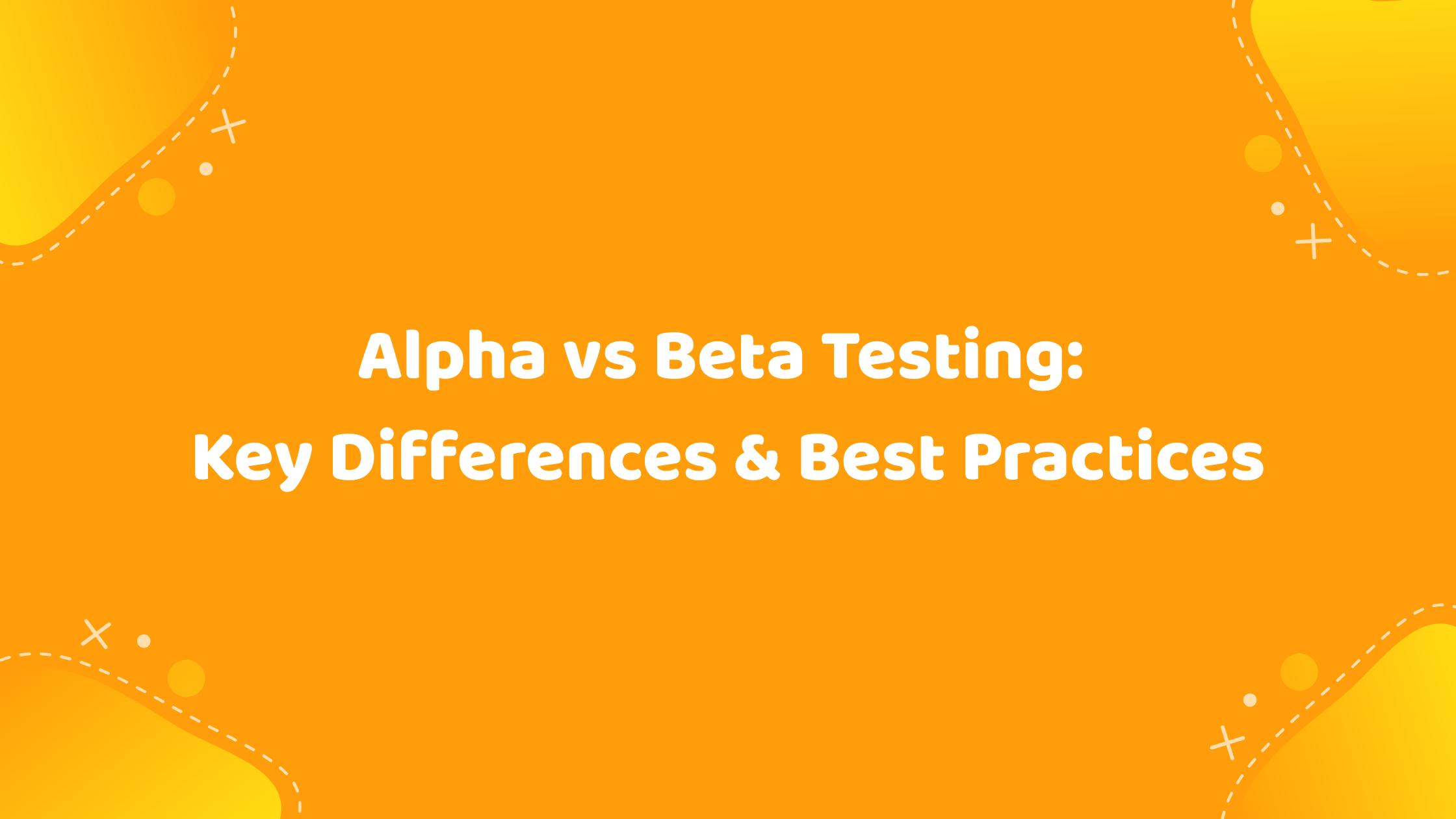 Have you ever released a feature only to see it break spectacularly in production? If you’re a developer or an SDET (Software Development Engineer in Test), you’ve likely been there. That’s where Alpha and Beta Testing come in - your last line of defense before your users turn into bug reporters!
Have you ever released a feature only to see it break spectacularly in production? If you’re a developer or an SDET (Software Development Engineer in Test), you’ve likely been there. That’s where Alpha and Beta Testing come in - your last line of defense before your users turn into bug reporters!
But what exactly are Alpha and Beta tests? How do they differ? And why should you, as a developer or SDET, care about them? Let’s break it down in a way that’s practical and interactive.
What Are Alpha and Beta Testing?
Before we jump into the juicy details, let’s define these two crucial testing phases:
-
Alpha Testing – The first round of external testing, performed by internal testers (developers, QA teams, and stakeholders) in a controlled environment.
-
Beta Testing – The second round of testing, where real users try the software in an uncontrolled, real-world environment before full release.
Why Do These Tests Matter?
Imagine launching a new feature without testing it in real-world conditions. It’s like pushing a car onto the highway without checking if the brakes work.
Alpha and Beta Testing reduce the risk of catastrophic failures and improve overall user experience. They help answer questions like:
-
Does the product meet business requirements?
-
How does it perform under real-world conditions?
Our Amazing SponsorsDigitalOcean offers a simple and reliable cloud hosting solution that enables developers to get their website or application up and running quickly.View Website
Laravel News keeps you up to date with everything Laravel. Everything from framework news to new community packages, Laravel tutorials, and more.View Website
A Laravel Starter Kit that includes Authentication, User Dashboard, Edit Profile, and a set of UI Components. Learn more about the DevDojo sponsorship program and see your logo here to get your brand in front of thousands of developers.View Website
-
Are there any unexpected usability issues?
-
Are customers happy with it?
Alpha Testing: Your First Line of Defense
Who Performs It?
-
Internal developers
-
QA engineers
-
Sometimes, product managers & stakeholders
Where Does It Happen?
- A controlled, internal environment (e.g., staging server, test devices)
Goals of Alpha Testing
-
Catch major functional bugs early
-
Identify usability issues before external users see them
-
Ensure core functionality works as expected
How to Conduct Alpha Testing
Alpha Testing is like a pre-release stress test done by people familiar with the software. Here’s how you can run an effective Alpha test:
-
Define Test Scenarios – Focus on core workflows and expected user interactions.
-
Use Debugging Tools – Leverage tools like logs, debuggers, and profiling tools.
-
Conduct Exploratory Testing – Let testers freely navigate and find unexpected issues.
-
Fix Critical Bugs – Address high-priority issues before moving to Beta.
-
Get Stakeholder Feedback – Ensure business goals are met.
Example: You’re building a new payment gateway feature. In Alpha, your developers and QA team will test if transactions process correctly in different scenarios-valid transactions, invalid card details, network failures, etc.
Beta Testing: The Real-World Experiment
Who Performs It?
- Real users (external customers, early adopters)
Where Does It Happen?
- Live production-like environments
Goals of Beta Testing
-
Validate real-world performance & usability
-
Gather user feedback for improvements
-
Ensure scalability before the full launch
How to Conduct Beta Testing
Unlike Alpha, Beta Testing is more unpredictable—it depends on real users in real environments. To make it successful, follow these steps:
-
Choose Your Beta Testers Wisely – Identify a diverse group of users (tech-savvy, non-tech users, different demographics).
-
Provide Clear Testing Instructions – Guide users on what to test but allow natural interactions.
-
Collect & Analyze Feedback – Use surveys, feedback forms, and bug reports.
-
Monitor Performance Metrics – Track errors, crashes, and user behavior analytics.
-
Fix & Iterate – Address critical issues before the full launch.
Example: After internal testing of your payment gateway, you release it to 1,000 beta users and track real-world performance. You might discover an issue where users from a specific region face payment failures due to bank API differences. That’s something you wouldn’t have caught in Alpha testing!
Alpha vs Beta Testing: Key Differences
| Feature | Alpha Testing 🏗️ | Beta Testing 🌍 | | --- | --- | --- | | Who Tests? | Internal team (devs, QA) | Real users (customers, early adopters) | | Environment | Controlled, staging servers | Real-world, production-like | | Goal | Find bugs before external release | Gather user feedback & ensure usability | | Bug Severity | High-impact issues | Minor usability or performance issues | | Test Focus | Functional, security, and usability | User experience and performance | | Outcome | Bug fixes, feature validation | Product refinements before launch |
Tools for Alpha & Beta Testing
To make the most out of these testing phases, use the right tools:
Alpha Testing Tools:
-
Bug tracking: Jira, Bugzilla, Trello
-
Testing automation: Selenium, Cypress, JUnit
-
Performance profiling: New Relic, Datadog
-
API Testing & Mocking: Keploy
Beta Testing Tools:
-
User feedback: Google Forms, SurveyMonkey
-
Crash reporting: Sentry, Firebase Crashlytics
-
Feature flagging: LaunchDarkly
Conclusion
Alpha and Beta Testing are critical for shipping stable, high-quality software. While Alpha Testing helps developers and QA teams catch major issues in a controlled environment, Beta Testing exposes the software to real-world users, ensuring usability and scalability. By implementing both, you reduce risks, improve user experience, and make data-driven refinements before launch. In short, test smart, release confidently!
FAQs
1. What is the main difference between Alpha and Beta Testing?
Alpha Testing is conducted internally by developers and QA teams in a controlled environment, while Beta Testing involves real users testing the software in a real-world scenario.
2. Can a product skip Alpha Testing and go directly to Beta Testing?
No, skipping Alpha Testing increases the risk of exposing critical bugs to real users, which can harm your product’s reputation and user experience.
3. How long should Alpha and Beta Testing last?
Alpha Testing typically lasts a few weeks, depending on the complexity of the software. Beta Testing can range from a few weeks to months, depending on the feedback cycle.
4. What are the biggest challenges in Beta Testing?
Ensuring active user participation, managing feedback effectively, and analyzing diverse real-world conditions can be challenging.
5. How do you choose Beta Testers?
Select a diverse group of real users who represent your target audience, including different demographics, device types, and technical expertise levels.
6. Is Beta Testing only for software, or can it be used in hardware products too?
Beta Testing applies to both software and hardware. Companies use Beta Testing to gather real-world insights before launching hardware products like smartphones and wearables.

Comments (0)